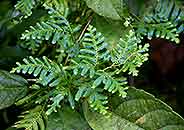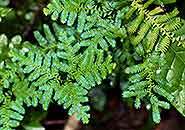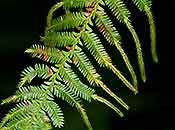Selaginella myosurus (Sw.) Alston
Synonyms |
Lycopodium myosurus Sw. |
|---|---|
Common name |
|
Description |
Plant with main stem climbing and winding to the right (dextrovolubile), up to 2 m x 1-1.5 mm diam., branched; lateral branches c. 12 x 4 cm, pinnate, oblong-lanceolate in outline, with lateral leaves spaced on the main axis and overlapping on the ultimate branches; ultimate ramifications about 2 x 7 cm (leaves included); rhizophores up to 30 cm long by 0.75 mm in diameter, streaked or buff when dry, glabrous, abruptly deflected; ventral rhizophores with a short papilla. . Leaves homomorphic on main stem, heteromorphic elsewhere. Main stem leaves c. 3 mm long, spaced 1 cm apart, ovate, apex tapering, base subulate, margin subentire, with two broad acute auricles at base; lateral leaves of the main branches unequal, the upper side semi-lanceolate, base rounded. Ultimate branches lateral leaves 3-3.5 x 1-1.5 cm, slightly falciform, apex mucronate-acruminate, unequal, margins with 1-3 rows of elongated cells, midrib raised on the upper side, not quite reaching the top; axillary leaves ovate, acute, denticulate, with or without short auricles; median leaves ovate-lanceolate, with a blade about 1-1.8 x 0.5-0.8 mm, denticulate, acuminate, long awned, the awn about half the length of the blade. Strobili solitary at the end of the final branches, usually about 1-4 cm long by 2-3 mm in diameter; sporophylls homomorphic (except those with megasporangia, which are slightly larger), ovate-deltoid, long-acuminate-awned, serrulate, articulated. |
Notes | |
Derivation | |
Habitat | Damp undergrowth, clearings, edges of streams of dense primary and secondary humid forests, dense dry forests, swamp or periodically flooded forests, riparian forests, shrubby forest, palm groves, vicinity of falls, post-cultivation fallows, plantations. |
Distribution worldwide | See African distribution. |
Distribution in Africa |
Angola, Cameroon, Congo, Dem. Republic of Congo, Equatorial Guinea (incl. Bioko), Gabon, Gambia, Ghana, Guinea, Ivory Coast, Liberia, Nigeria, Senegal, Sierra Leone, Togo. |
Growth form |
Climbing, terrestrial. |
Literature |
|







